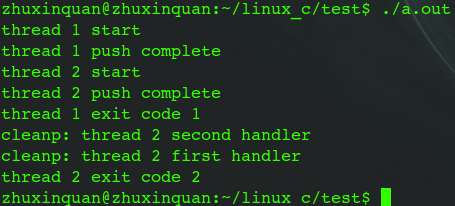linux提供了一对函数用于自动释放资源,声明如下:
#include <pthread.h>
void pthread_cleanup_push(void (*routine)(void *), void *arg);
void pthread_cleanup_pop(int execute);- 线程可以建立多个清理处理程序,处理程序在栈中记录,所以执行顺序与注册时顺序相反。
- 只有当线程执行以下动作时才会调用清理函数,调用参数为arg。
- 调用pthread_exit时
- 响应取消请求时
- 用非零execute参数调用跑thread_cleanup_pop时
- 若excute参数设置为0,清理函数将不会被调用。无论是否调用pthread_cleanup_pop函数都将删除上次pthread_cleanup_push调用建立的清理处理程序。
- 这一对函数是通过宏来实现的,随意必须成对使用
下面是一个关于线程清理处理程序的示例:
#include<stdio.h>
#include<pthread.h>
#include"apue.h"
void cleanup(void *arg)
{
printf("cleanp: %s\n", (char *)arg);
}
void * thr_fn1(void *arg)
{
printf("thread 1 start\n");
pthread_cleanup_push(cleanup, "thread 1 first handler");
pthread_cleanup_push(cleanup, "thread 1 second handler");
printf("thread 1 push complete\n");
if(arg)
{
return ((void*)1);
}
pthread_cleanup_pop(0);
pthread_cleanup_pop(0);
return ((void *)1);
}
void *thr_fn2(void *arg)
{
printf("thread 2 start\n");
pthread_cleanup_push(cleanup, "thread 2 first handler");
pthread_cleanup_push(cleanup, "thread 2 second handler");
printf("thread 2 push complete\n");
if(arg)
{
pthread_exit ((void*)2);
}
pthread_cleanup_pop(0);
pthread_cleanup_pop(0);
return ((void *)2);
}
int main(void)
{
int err;
pthread_t tid1, tid2;
int tret;
err = pthread_create(&tid1, NULL, thr_fn1, (void *)1);
if(err != 0)
{
err_quit("can't create thread 1: %s\n", strerror(err));
}
err = pthread_create(&tid2, NULL, thr_fn2, (void *)1);
if(err != 0)
{
err_quit("can't create thread 2 :%s\n", strerror(err));
}
err = pthread_join(tid1, (void *)&tret);
if(err != 0)
{
err_quit("can't join with thread 1: %s\n", strerror(err));
}
printf("thread 1 exit code %d\n", (int)tret);
err = pthread_join(tid2, (void *)&tret);
if(err != 0)
{
err_quit("can't join with thread 2: %s\n", strerror(err));
}
printf("thread 2 exit code %d\n", (int)tret);
exit(0);
}程序的运行结果如下:

通过结果可以看出两线程都正确的启动和退出了,但只调用了第二个线程的清理处理程序,所以如果线程是通过它的启动例程中返回而终止,则不会调用清理处理程序。
启动例程:调用其他线程的父进程称之为启动例程,也可认为是第一个执行的线程。
则在本例中main函数为启动例程,在thr_fn1函数中虽然也使用了调用了线程清理处理程序,但是由于中间是通过return返回到启动例程当中,所以线程清理处理程序并未执行。而在thr_fn2函数中使用的是pthread_exit退出的,满足调用线程清理处理函数的条件,因而被执行。同时通过执行结果的倒数二三行,可以看出 pthread_cleanup_push的注册顺序与最后的执行顺序是相反的。